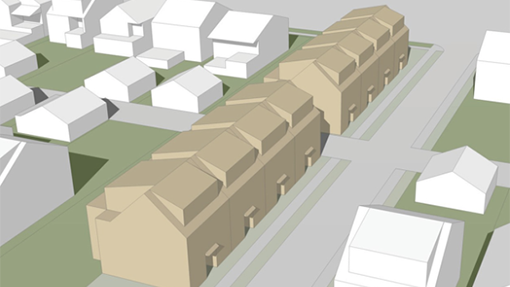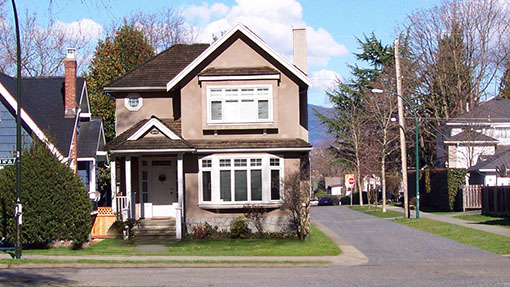Thin Streets: Asphalt to affordable housing
Many cities have the potential to transform under-utilized road space into public land. Little used two-way streets can be turned into narrow one-way streets, making the leftover street space available for low-cost housing, or some other public purpose.
Taking over some street space would not only provide valuable city land at no cost, it would also increase pedestrian safety, reduce traffic volume and speed, reduce automobile collisions, reduce the heat island effect that occurs in cities, and reduce rainwater runoff.
In Vancouver, dividing the typical 66’ right of way in half, produces two new 33’ residential lots per block, and a narrower 33’ right-of-way, with a 17’ thin street, sufficient for one way travel, parking for cars, a sidewalk for pedestrians, and boulevards for street trees. Two new lots are now available for public use such as affordable housing, park space, community facility, community gardens, daycare centres.
In Vancouver, the proposal in single-family zones would:
• make room for 10,000 to 20,000 units of ground-oriented housing;
• establish an endowment fund ranging from $ 2 billion dollars to $4 billion from the lease of the new lots which would be used to support affordable housing and needed neighbourhood improvements;
• avoid rezonings or the demolition of existing housing
Sewer, water, gas, telephone, and electrical services are normally provided to the front or rear of building lots on the ‘long’ face of a block. As a result, the quiet north-south streets at the ends of blocks are relatively free of underground services.


The idea behind Thin Streets originated in Vancouver, the result of two city planners, Chris DeMarco and Ted Sebastian, who cycled to work for years during rush-hour. They noticed that there was virtually no traffic on the 40 plus north-south streets that we crossed, even in apartment areas. Traffic count data confirmed these observations.
On these streets, road narrowing would not affect emergency vehicle access, pedestrian and bike routes, or normal auto access. Nor would it affect sewer, water, gas, telephone, and electrical services, normally provided at the front or rear of building lots.
Thin Streets was one of three winners of a City of Vancouver affordable housing competition in 2012.

What about parking?
Many north-south streets have few houses facing the street and few parked cars. This proposal would continue to allow parking one side of the street.
What about corner property owners?
The property owner who now lives on the corner will find themselves one lot in when the new lot is created. While assessed values do not show a preference for corner lots, people often select a corner property for the extra light it offers. The objections of existing corner lot owners could be addressed in two ways. The city could compensate corner lot owners with a cash settlement. Or it could buy up corner lots when they become available.
Image >> Vancouver’s residential grid. Added street lots are shown in green, an easy option when there are no existing houses facing the n-s street.

A means to affordable housing
The city owns the street so the new lots would cost nothing. The affordability of units built on these lots would be increased in several ways:
Leasing Rather Than Owning: Each new lot would be leased rather than sold. A leased property has a lower value than an identical parcel with freehold title since there is an identified end to the tenure.
Removing Financing Costs: The city could charge an annual or monthly leasing fee rather than requiring a prepaid land lease. New residents would not need to pay the significant borrowing costs required for a prepaid lease on the land portion of the home.
Reducing Holding Costs: Builders typically hold one or more properties for future development. They must add the cost of holding properties to the cost of a lot when they build. These costs would be nil for lots made from streets.
Increasing Supply: A significant increase in supply would help reduce the price of ground-oriented housing.
Increasing Property Tax Base: Adding new land would spread the load, reducing the taxes of existing residents and businesses.
Creating Endowment Funds: The land lease revenue from the new lots created by our proposals could be used to create endowment funds as described below.

Housing Scheme 1
4 duplex houses @ 940 square feet each, plus 4 suites @ 446 square feet, for 8 units total. Permitted in RS districts, no rezoning required.

Housing Scheme 3
The two new lots are consolidated with two corner lots. This scheme has 24 units per block. 16 duplex-row houses @ 700 square feet, plus 8 apartments @ 580 square feet.

Housing Scheme 2
8 row houses @ 820 square feet. New lots are 36 feet wide. Each house has a 12 x 24 foot rear yard garden.

Housing Scheme 3 – rear view
Ground units have 24 x 24 foot gardens. Top floor units have roof gardens.
A Range of Benefits
This idea has benefits well beyond affordable housing. We propose that the revenues generated be allocated to three purposes:
A Neighbouhood Enhancement Fund, for civic works such as pocket parks, community gardens, bike ways and traffic calming in neighbourhoods where projects are taking place.
A City-wide Enhancement Fund, so proceeds can be shared with areas where these projects cannot be implemented.
An Affordable Housing Fund, to be used to build social housing projects or subsidize rents in housing projects created by this scheme.
Other community benefits:
- adding population to help to keep schools open and businesses alive;
- providing seniors with housing choices in their own neighbourhood;
- reducing the cost of road maintenance;
- adding taxable assessment to the city’s tax base;
- creating a continuous construction program, and new jobs;
- calming traffic in residential neighbourhoods;
- providing lower cost housing away from busy streets.
Enormous Potential
Our analysis shows a potential 3430 block faces in the RS Districts in Vancouver. Each block face has two lots, one on the north and one on the south side of east-west street, resulting in 6860 lots.
Scheme 1 potential under existing zoning: 4 housing units x 6860 = 27,440 units.
Assuming an average lot value of $1,200,000 net after site preparation, road and servicing reconstruction costs, the financial return would be: $1,200,000 x 6860 = $8.2 billion.
Taking a cautious view that only 50% of the blocks could be used because of adjacent arterials, schools, parks, or major services, under Scheme 1, Vancouver could acquire approximately 14,000 units of ground-oriented housing, and a $4 billion dollar fund without demolishing a single unit of existing housing, or undertaking a single rezoning.
Lot identification could begin immediately, and the first homes could be built within 18 months. The other schemes would require rezoning but offer considerably more density.
(Revised – June 2020)

Carnarvon at 14th showing an existing Vancouver N-S street. Vancouver ranks as North America’s 2nd least affordable city (in terms of housing).

New thin street with a house added on a new lot. See above for better examples that focus on multiple housing.
What about other cities?
Many of the most expensive have a vast untapped resource in streets that are far too wide. The images below were randomly chosen from residential neighbourhoods about 1.5 miles from the city center – a walk or short bike ride. Affordability is based on the difference between median household income and the income required to buy the median-priced home.

San Francisco: #1 least affordable city. Above: Sanchez Street. Many residential streets are so wide parallel parking is not necessary.

San Jose: #5 least affordable city. Above: North 15th Street. Facing houses make the creation of thin streets more difficult. But this can be overcome by extending new developments into the street, and adding a park or another amenity on either side.

Los Angeles: #3 least affordable city. Above: Matthews Steet.

San Diego: # 7 least affordable city. Above: L Street.
Wide streets are not only wasteful of land in the most expensive cities; they promote automobile accidents, generate heat islands and increase rainwater runoff, a problem in the hottest, driest cities. For more info watch this short video on residential streets.
